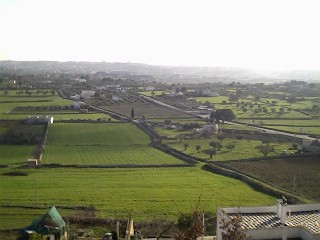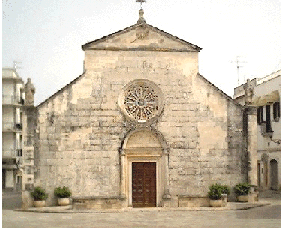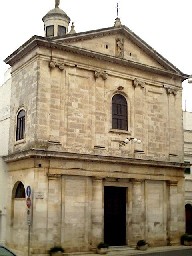|
On
the walls of the entrance to the chapel there are a
seventeenth-century fresco of St. Donato Bishop and a
seventeenth canvas of Resurrected Christ, both by unknown artist.
Beside you can see the altar of the “Assumption, enshrouded in
a canvas by Maldarelli (1838). The portrait of St. George at the
bottom of the apse and the “Fall of the Angels’ painted in
1839 on the altar of St. Michael by the door which leads to the
staircase of the Soccorpo (crypt) are also by Maldarelli. Of
great artistic interest is the marble altar of the Holy Rosary
(1764) with a canvas and 15 ovals pictures by the painter
Francesco De Mauro of Martina Franca. Beside the entrance you
flnd a Baptistery in polycrome marble by the Neapolitan sculptor
Fedele Caggiano, the major altar
was sculptured in 1861 by the
same artist, and the commemorating monument to the founder by
the Neapolitan Pasquale Ricco; both works are of the first half
of the nineteenth-century. Beside the Mother Church, there is
the seventeenth-century Church of Our Lady of the
Annunciation, erected on the site of an oratory in 1633. The
building englobes in the back part a groundfloor room survived
from the 1560’s hospital.
|
|
Inside
the church are kept wooden statues from different periods: the
ones of the Mysteries by the painter and sculptor Antonio
Semeraro of Locorotondo are dated to the nineteenth-century; the
others, of unknown origin, are late eighteenth-century. On the
right of the Mother Church, to
Via Dura
and then to Via Aprile,
you are in the oldest part of the town. The alleys are very
narrow and the houses are huddled together.
Largo Bellavista
gives
you a surprisingly beautiful panoramic view of the Itria
Valley. Crossing Via Garibaldi you come to Via Porta Nuova
and then to Via Camerette and finelly to Via Giannone and down
to the wide staircase to Via Cavour. On the right the
Church
of Our Lady of Greca, a building of undoubtful charm. This
church can be dated to the end of 1400, even if the existence of
a more ancient nucleus has been confirmed. It has a basilica set
up with a nave and two aisles, with an ogival, ribbed cross
vault in the center and flying semibarrel vaults on the sides.
The basis of the bundle pilars and of the capitals are a
combination of classical and medieval motives. To contast the
late-Gothic taste of the structure there is a great display of
Renaissance sculptures (late 1500): the stone polyptch of the
high altar, the altar-frontal representing the Deposition of
Christ, the St. George group, the statue of the client of the
sixteenth-century finding of the church, the statue of Our Lady
of Grace and other fragments. Of great importance are the fresco
fragments on the right wall, of a Madonna with Infant, belonging
to a more ancient nucleus. Outside, the building is completed by
two statues of the end of the fourteenth-century, the rosette
remade in 1981, and the unique layered roof called “a
cummerse’. Going back along Via Cavour you find the
Church
of St. Rocco, erected in 1804 on the site of another church
dated to 1568, shaped as an apsidel and domed Greek cross. It
was enlarged in 1872.
|
|
Inside
is kept the large canvas of St. Rocco with the plague-stricken
people, by Antonio Semeraro, 1854, as well as two smaller
canvases of St. Irene and St. Francis of Paola and two
eighteenth-century stone statues; St. Rocco wooden statue on the
altar was executed in Naples in 1792. Going along Via Cavour to
the crossroad with Via Bonifacio, where you still find the rows
of some houses which were part of the eighteen-century
“borgo” (village) outside the walls Further on you come to
Corso XX Settembre and A. Moro square, where the new town hall
(1952) stands. On the left of the square there is the
seventeenth-century Chapel of the Holy Spirit. Going down
on the right to Marconi square, leaning against the hospital
there is the small Church of St. Mary of the Martyrs, erected
in 1500. In the outskirts of the town there is the Church of
Our Lady of the Chain (1897), formed by an upper part and
underground part, containing the remains of a
seventeenth-century cave-chapel where a late-sixteenth-century
niche of a Madonna with Infant is kept, once belonging to the
old Mother Church. There is also the Church of St. Mark, (1687),
located at about 5 km from the town.
|
 |
previous
page |
 |
home
page |
 |
photos |
 |
restaurant
& hotels |
|
|
|
 |
|
Itria
valley
|
|
 |
|
Fra
Giuseppe Andrea Rodio square |
|
|
|
 |
|
Via Dura
|
|
|
|

|
|
Largo Bellavista
|
|
|

|
|
Church
of Our Lady of Greca |
|
|

|
|
Church
of St. Rocco
|

|
|
Nardelli street
|
|
|
|

